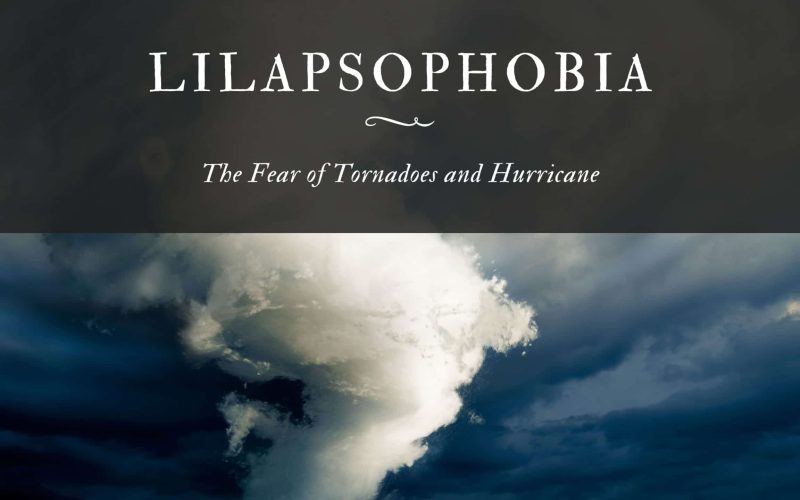Natural disasters are not the best experiences. Unless you are a storm chaser, there is little or no possibility that you will look forward to natural disasters. This explains why some people may have lilapsophobia.
If you are wondering what lilapsophobia is, it is the fear of hurricanes and tornadoes, and it can be seen as a more severe variation of astraphobia, also known as the fear of lightning and thunder.
If you have lilapsophobia, you are afraid of not the average summer storm but the possibility of a severe one. This phobia is relatively common, although it is rarer than astraphobia.
Causes of Lilapsophobia
Like many other phobias, the fear of hurricanes and tornadoes is often traced to a negative experience.
Perhaps a person with lilasophobia has once been affected by severe weather conditions that caused property damage or personal injury to you or someone dear to you.
Or such a person may have been spared by a hurricane or tornado that wreaked havoc in your environment, possibly throwing in a bit of survivor guilt.
If you have had to experience a genuinely devastating storm like Hurricane Katrina, you must seek professional advice. Asides dealing with a phobia like lilapsophobia, it is quite possible that you are dealing with post-traumatic stress disorder.
Lilapsophobia, just like many phobias, can be learned. If your friends, parents, or relatives are afraid of hurricanes and tornadoes, you may have unknowingly picked up their fear.
Symptoms of Lilapsophobia
While it is quite normal and rational to check weather forecasts before any outdoor activities, many people who suffer from lilapsophobia discover that the weather now controls their lives and everything related to them.
If you have lilasophobia, you may spend much time tracking the weather online or watching the weather channel. You may not feel like going out on days when a possible storm is predicted.
Whenever a storm hits, you may find yourself displaying unusual behaviors. Repeatedly looking out for weather alerts, hiding in the closet or under the bed, and going as far as putting a whole tornado plan into effect immediately, the rain starts are all common among people with this fear.
You might find yourself listening carefully to the storm for sounds that depict tornado activity, or you might plan to drown out the storm entirely with movies or loud music.
Many people have found out that lilapsophobia gets worse by being alone. You might need to call friends in a panic or begin to arrange your schedule so that you are hardly ever alone.
Some people who have this phobia feel that going to the movies, a mall, or a library can help them stay sane and control their panic. Over time, you may discover that your daily activities gradually shrink and become more and more restricted.
Also, you might become resistant and unwilling to go into buildings that you think are not “safe,” even on a bright, sunny day. You may refuse to take part in any outdoor activities or go on long road trips out of fear that there might be a storm.
The Appearance of Lilapsophobia in Children
Many children may go through a phase of astraphobia or an intense fear of storms. However, lilapsophobia is not one phobia that is as common in children as they are in adults, but it may undoubtedly appear.
Young children who are learning to draw the line between fantasy and reality may be especially susceptible to fears caused by adult conversations and media images.
If a major storm has been profiled on TV or discussed by grownups, kids may become scared that it may happen to them.
Because fears are known to be a regular part of child development, phobias are usually not diagnosed in kids unless they persist for longer than half a year (six months).
Try to reassure your kids about the relatively rare significant storms, and also explain your planned storm readiness procedures to your child.
Of course, it is essential to tell your child’s doctor if the phobia is a severe or persistent one, as it may be necessary to get a therapist referral.
Appearance in Popular Culture
Hollywood movies such as the 1996 Twister have addressed the effects of lilapsophobia. In that movie, Dr. Jo Harding, played by Helen Hunt, saw her father die in a tornado.
As an adult, she began to fight the resulting lilapsophobia by becoming a storm chaser. The movie features highly realistic footage of actual tornadoes, so we do not recommend it for those suffering from this fear.
Hurricanes and Tornadoes are part of our daily lives, and today’s media provides the opportunity to view destructive and devastating storms and their aftermath repeatedly in high-definition detail.
Even though we all agree that coverage is very important, it is also essential that such coverage is put into perspective. While small weather events occur frequently, only those that cause severe damage are deemed newsworthy.
The available media coverage may easily cause a skewed belief that storms of such magnitude are much more common than they really are.
How to Be Rationally Prepared for Storms?
Although the chances that you will be caught in a killer storm are quite small, we will not deny that the risks are real. Therefore, you must always be prepared, especially in a high-risk environment.
The key here is for you to recognize the difference between rational preparedness and possible phobic reactions. If you reside in a storm-prone area, then your area must have official preparedness literature.
You will need to get a copy of that literature, as such documents may be distributed online, in libraries, grocery stores, and other public locations, or through official websites. You read through the available recommendations and set up a storm readiness plan.
If there are other people in your household, make sure that someone else monitors the weather. That person is best positioned to alert you about possible dangers and help you decide on the best course of action.
Hopefully, this will relieve some pressure and may even help you overcome any obsessive checking. Make sure that you have the right information on the kind of storms that affect the area where you live.
For example, it is public knowledge that hurricanes can be quite devastating, but they are predicted long before they occur. Tornadoes can develop very quickly, but they only do so under specific weather conditions.
You should learn about the kinds of storms that may hit your environment, as they can help you make rational decisions about dealing with them.
Treatment of Lilapsophobia
Just like many types of phobias, it is possible for lilapsophobia to be treated with cognitive-behavioral therapy techniques. Nevertheless, if your phobia is a result of post-traumatic stress disorder, you may need other types of therapy.
Talk to a therapist so that the root of your phobia can be diagnosed and the right course of action can be prescribed.
We hope that you found this article helpful. Kindly leave a comment below.








